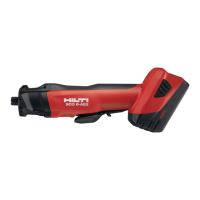Why does the Hilti Cutter battery run down more quickly than usual?
- YypierceSep 12, 2025
If the battery runs down more quickly than usual, it may be due to a very low ambient temperature. Allow the battery to warm up slowly to room temperature.

Why does the Hilti Cutter battery run down more quickly than usual?
If the battery runs down more quickly than usual, it may be due to a very low ambient temperature. Allow the battery to warm up slowly to room temperature.
How to fix a Hilti Cutter battery that doesn’t engage with an audible click?
If the battery doesn’t engage with an audible click, the retaining lugs on the battery might be dirty. Clean the retaining lugs and refit the battery.
| Battery platform | 22V |
|---|---|
| No-load speed | 10000 - 20000 rpm |
| Chuck type | Keyless chuck |
| Battery voltage | 21.6 V |
| Number of gears | 1 |
| Battery Type | Li-Ion |
Read before operation for safe, trouble-free handling and use of the product.
Explains signal words, symbols in documentation, and symbols in illustrations for safe operation.
Lists and explains symbols found on the product itself, like PPE and electrical indicators.
Details product type, model, and serial number for identification and service.
States product compliance with directives/standards; technical documentation location.
Crucial safety guidelines for operating power tools, covering work area, electrical, and personal safety.
Advises on keeping the work area clean, well-lit, and free from hazards.
Covers safe practices for power tool plugs, grounding, wet conditions, and cords.
Emphasizes alertness, using PPE, preventing unintentional starting, and proper posture.
Guidelines for safe and proper usage, maintenance, and storage of power tools.
Specific instructions for charging, using, and handling lithium-ion batteries safely.
Information on servicing the power tool by qualified personnel using identical replacement parts.
Specific safety advice for cut-out tools, including workpiece securing and personal safety.
Secure the workpiece firmly to prevent instability and loss of control during operation.
Use tool only if faultless, never tamper, hold securely, avoid rotating parts, wear PPE.
Illustrates and labels the main components and features of the cut-out tool.
Describes the product's purpose and recommended applications for making cut-outs.
Lists the components included with the cut-out tool package.
Explains the built-in motor protection system that prevents overheating.
Lists accessory tools and bits compatible with the cut-out tool for different materials.
Provides specifications like voltage, speed, temperature ranges, and weight.
Specifies the available collet sizes for accessory tools.
Lists the shank diameters compatible with the tool's collets.
Specifies the recommended operating temperature range for the battery.
Instructions for preparing the work area and the tool before operation.
Step-by-step guide on how to properly insert the battery into the tool.
Step-by-step guide on how to safely remove the battery from the tool.
Instructions on how to correctly attach and secure an accessory tool to the cut-out tool.
Instructions on how to safely detach and remove an accessory tool from the cut-out tool.
Detailed steps for replacing the collet with a different size.
Instructions on how to attach and adjust the depth gauge for controlled cutting.
Steps to attach the optional vacuum cleaner hose connector.
Important warnings regarding operation of switches during use.
Guidance on how to hold the tool securely with both hands for stable operation.
Explains the function of the safety lock and how to switch the tool on.
Instructions on how to safely switch off the power tool.
Steps for guiding the tool into material and performing the cut with steady pressure.
Instructions for cleaning dirt, air vents, and casing, avoiding specific cleaning agents.
Advice on keeping batteries clean, dry, and free from contaminants.
Regular checks for damage, ensuring proper function, and fitting guards after maintenance.
Safety precautions for transporting the tool and batteries to prevent accidental starting.
Guidelines for storing the tool and batteries in a cool, dry place, away from children.
A table listing common problems, their possible causes, and recommended actions.
Warning and instructions for safe and environmentally responsible disposal of the tool and batteries.
Information on warranty conditions and where to get assistance.